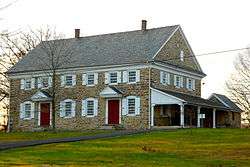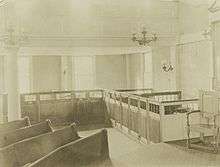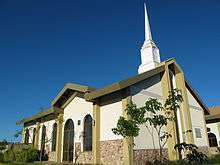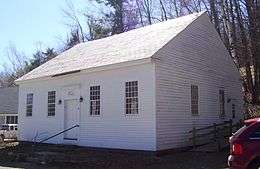Meeting house
A meeting house (meetinghouse,[1] meeting-house[2]) is a building where religious and sometimes public meetings take place.
Meeting houses in America
The colonial meeting house in America was typically the first public building built as new villages sprang up. A meeting-house had a dual purpose as a place of worship and for public discourse, but sometimes only for "...the service of God."[3] As the towns grew and the separation of church and state in the United States matured the buildings which were used as the seat of local government were called a town-house[4] or town-hall.[5]



Many nonconformist Christian denominations distinguish between a
- Church, which is a body of people who believe in Christ
- Meeting house or chapel, which is a building where the church meets
The nonconformist meeting houses generally do not have steeples, with the term "steeplehouses" being used to describe traditional or establishment religious buildings.[6] Christian denominations which use the term "meeting house" to refer to the building in which they hold their worship include:
- Anabaptist congregations
- Congregational churches with their congregation-based system of church governance. They also use the term "mouth-houses" to emphasize their use as a place for discourse and discussion.
- Christadelphians
- The Church of Jesus Christ of Latter-day Saints (Mormons) uses the term "meetinghouse" for the building where congregations meet for weekly worship services, recreational events, and social gatherings.[7][8] A meetinghouse differs from an LDS temple, which is reserved for special forms of worship.[9][10]
- Provisional Movement
- Religious Society of Friends (Quakers), see Friends meeting houses
- Spiritual Christians from Russia
- Some Unitarian congregations, although some prefer the term "chapel" or "church".
- The Unification Church
The meeting house in England
In England, a meeting house is distinguished from a church or cathedral by being a place of worship for dissenters or nonconformists.[11]
See also
References
- "Meeting house" in Merriam-Webster Dictionary
- Oxford English Dictionary Second Edition on CD-ROM (v. 4.0) Oxford University Press, 2009
- Sweeney, Kevin M.. "Meetinghouses, Town Houses, And Churches: Changing Perceptions Of Sacred And Secular Space In Southern New England, 1720–1850." Winterthur Portfolio 28.1 (1993): 59. 1. Print. JSTOR 1181498
- Sewall, J. B. "The New England Town-house", The Bay State Monthly, Vol 1, No 5. 1884. 284–290. Print. Accessed 12/6/2013
- Whitney, William D. (ed.) The Century Dictionary vol. 8. 1895. 6407. Print. Town-house may also mean a jail, poor-house, or house not in the countryside. See Century Dictionary
- Quaker Spirituality: Selected Writings. HarperCollins. 2005. p. 18. ISBN 9780060578725.
- Hamilton, C. Mark (1992), "Meetinghouse", in Ludlow, Daniel H (ed.), Encyclopedia of Mormonism, New York: Macmillan Publishing, pp. 876–878, ISBN 0-02-879602-0, OCLC 24502140
- Seymour, Nicole (March 2006), "Standardized Meetinghouses Give a Place for More Members to Meet and Worship", Ensign, retrieved 2012-10-10
- "Of Chapels and Temples: Explaining Mormon Worship Services" (News Release), Newsroom, LDS Church, 15 November 2007, retrieved 2012-10-10
- "Topics and Background: Templaes", Newsroom, LDS Church, retrieved 2012-10-10
- Oxford English Dictionary Second Edition on CD-ROM (v. 4.0) © Oxford University Press 2009
Sources
- Congdon, Herbert Wheaton. Old Vermont Houses 1763–1850. William L. Bauhan: 1940, 1973. ISBN 978-0-87233-001-6.
- Duffy, John J., et al. Vermont: An Illustrated History. American Historical Press: 2000. ISBN 978-1-892724-08-3.

